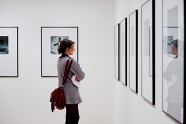| M | T | W | T | F | S | S |
|---|---|---|---|---|---|---|
| 1 | 2 | 3 | 4 | 5 | 6 | 7 |
| 8 | 9 | 10 | 11 | 12 | 13 | 14 |
| 15 | 16 | 17 | 18 | 19 | 20 | 21 |
| 22 | 23 | 24 | 25 | 26 | 27 | 28 |
| 29 | 30 | 31 | ||||

A Needle Walks into a Haystack, Claude Parent, La colline de l’art 2014. © Tate Liverpool
A Needle Walks into a Haystack, Claude Parent, La colline de l’art 2014. © Tate Liverpool
How do abstract propositions and physical reality meet in architecture and art, and how does that transformation or bridge affect us as users?
This one-day event takes architect Claude Parent’s Twelve Subversive Acts to Dodge the System as the starting point to discuss ideas and concerns common to architecture
In 2001, the radical French architect Claude Parent published a manifesto, Twelve Subversive Acts to Dodge the System, outlining a set of rules or a methodology that dissolves the categories and order systems on which architecture is conventionally determined. These rules, if followed, would enable a new freedom for thinking, which for Parent was turning a building into a landscape thereby reorganizing the social dynamics of its inhabitants.
Since the 1960s, Parent has been experimenting with similar ideas, initially with his collaborator, philosopher and urbanist Paul Virillio, which developed into what they termed Fonction Oblique. For Parent, ramps and sloped surfaces are a substitute for the conventionally orthogonal roles of walls, ceilings and floors - aesthetically inspired by World War II bunkers constructed along the Atlantic Wall.
Parent’s tools are the oblique, but the logic of a dispositif is broadly relevant proposition. For this symposium, Twelve Subversive Acts to Dodge the System, is a starting point for thinking about tools and devices that open up the imaginary orchestrating new conditions that enable unforeseen outcomes.
Art exhibitions and museums are also places where the abstract and the concrete meet, not only in the ideas and works of artists but also in the audience experience. Co-commissioned by Tate Liverpool and the 8th Liverpool Biennial,A Needle Walks Into A Haystack, Parent’s radical transformation of the Wolfson Gallery at Tate Liverpool offers new possibility for how works from Tate’s collection are viewed, and offers an alternative perspective of the physical and symbolic space of the museum.
The new architecture is a device for thinking and experiencing - intended not as historic revisionism of utopian or modernist architecture - but a contemporary re-negotiation of the tools, terms and processes available to and invented by artists working today.
Liverpool Biennial
55 New Bird Street
Liverpool L1 0BW
- T +44 (0)151 709 7444
- info@biennial.com
Liverpool Biennial is funded by
Founding Supporter
James Moores




